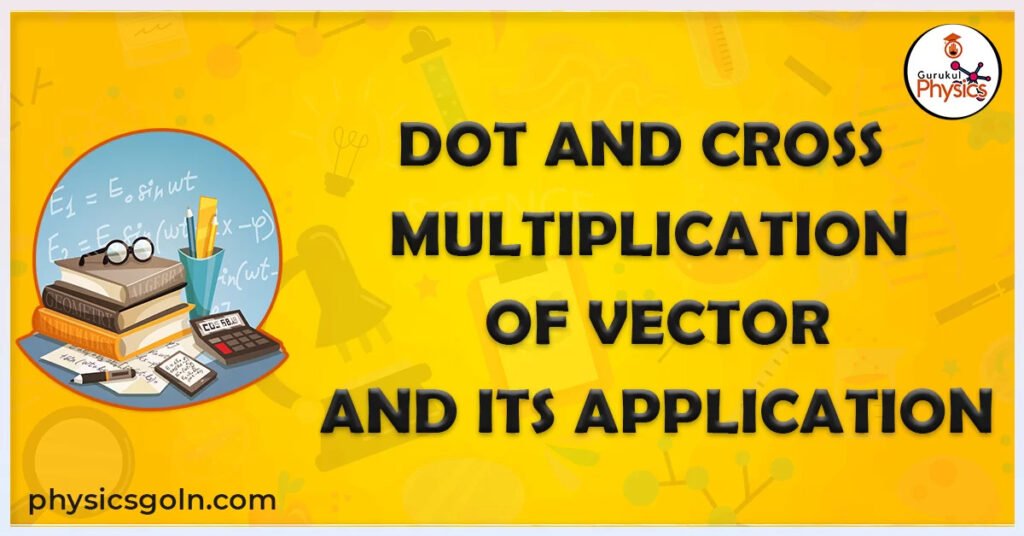Dot and cross multiplication of vector and its application : A vector is a quantity that is defined not only by its magnitude but also by its direction. Vectors include velocity, force, acceleration, momentum, and so on.
There are two techniques to multiply vectors
- Dot product or scalar product
- Cross product or vector product
[ Dot and cross multiplication of vector and its application ]
Scalar product of vectors/dot product
The output of two vectors’ scalar product/dot product is always a scalar number. Consider the following two vectors: a and b. The product of the magnitudes of a, b, and the cosine of the angle between these vectors yields the scalar product.
Scalar product = |a| |b| cos α
Here, |a| = magnitude of vector a
|b| = magnitude of vector b
α = angle between the vectors
A real number is always gotten while the scalar product of two vectors (scalar).
The commutative scalar product is a.b =b.a= |a||b| cosα
Scalar product is zero if α is 90°, since cos(90) = 0. As a result, the scalar product of unit vectors in the x and y directions is zero.
The scalar product is the product of the magnitudes of a and b |a||b| if is 0°.
A unit vector’s scalar product with itself equals 1.
|a|^2 is the scalar product of a vector a with itself.
The scalar product of vectors a and b is -|a||b| if is 180 degree.
Over addition, the scalar product is distributive.
The dot product indicates how much of the force vector is applied in the motion vector’s direction. The dot product may also be used to calculate the angle created by two vectors, as well as the location of a vector in relation to the coordinate axes. It also has a basic test to see if two vectors intersect at a straight angle.
Cross Product/Vector Product of Vectors:
Mathematically, the vector product C of two vectors a and b with an angle α between them is computed as
C= a × b = |a| |b| sin α
It’s important to keep in mind that the cross product is a vector with a specific direction. Both a and b are always perpendicular to the resultant.
Because sin(0) = 0 when a and b are parallel vectors, the resultant must be zero.
A vector quantity is generated by the cross product. Both a and b are always perpendicular to the resultant.
As sin(0) = 0, the cross-product of parallel vectors/collinear vectors is zero. i × i = j × j = k × k = 0
The product of two mutually perpendicular vectors of equal magnitude is one. Cross-product is not commutative (because sin(0)=1).
Cross product has not commutative properties.
a × b is not equal to b × a
Over addition, the cross product a × (b + c) = a × b+ a × c is distributive.
k(a × b) = k(a) × b = a × k(b) if k is a scalar
Rotating clockwise and taking the cross product of any two pairs of unit vectors yields the third resultant, whereas moving anticlockwise yields the negative resultant.
The following conclusions can be drawn:
i × j = k j × k = i k × i = j
j × i = -k i × k= -j k × j = -I
Determinant Form Cross Product
If a = a1i + a2j + a3k and b = b1i + b2j + b3k are the vectors a and b respectively, then
The cross product a x b may therefore be calculated in determinant form
a × b = i(a2b3 – b2a3) + j(a3b1 – a1b3) + k(a1b2 – a2b1)
The cross product can be used in a variety of situations. It is utilized in computational geometry, physics, and engineering, for example.
The cross product is used to calculate the distance between two skew lines (lines that are not in the same plane) in three-dimensional space.
The cross product may be used to get the normal of a triangle or polygon, which is a necessary requirement in computer graphics.
A particle’s angular momentum L around a particular origin is defined as:
where r is the particle’s position vector relative to the origin and p is the particle’s linear momentum
Similarly, the moment M of a force FB applied at point B around point A is calculated as follows:
:
The cross-product is used to describe the Lorentz force experienced by a moving electric charge qe
The cross-product is used in vector calculus to derive the formula for the vector operator curl.
In epipolar and multi-view geometry, the method of expressing a cross product in terms of a matrix multiplication arises frequently, especially when deriving matching constraints.
Read more:

